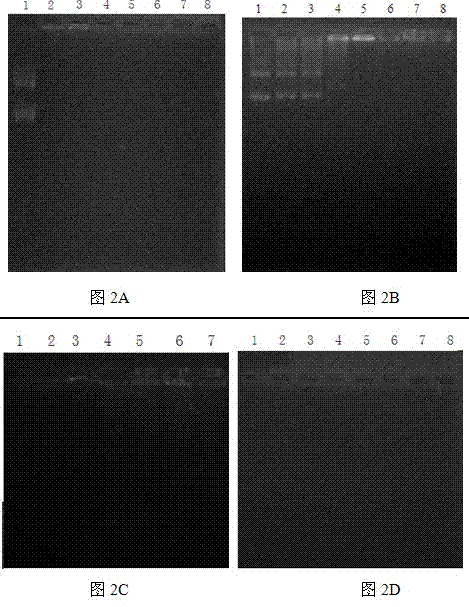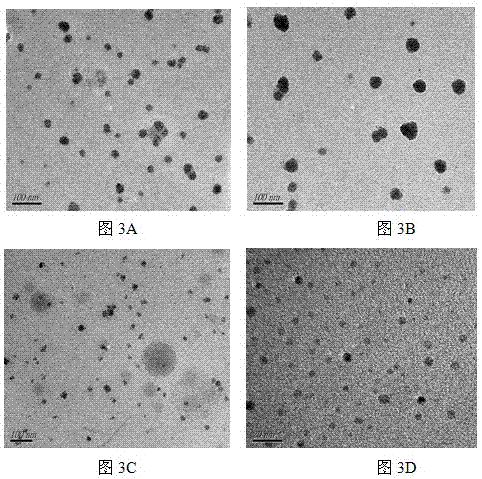Cationized polysaccharide nanoparticle gene delivery systems and manufacturing method thereof
A gene delivery system and cationization technology, applied in the field of cationized polysaccharide nanoparticle gene delivery system, can solve the problems of no positive charge and cannot be directly used as a gene, etc., and achieve good encapsulation and release effect, no immunogenicity, strong effect of proliferation
- Summary
- Abstract
- Description
- Claims
- Application Information
AI Technical Summary
Problems solved by technology
Method used
Image
Examples
Embodiment 1
[0055] Example 1: Preparation of the gene delivery system of the cationized Pleurotus eryngii polysaccharide-DNA plasmid nanocomposite modified by spermine
[0056] Weigh 0.5g refined Pleurotus eryngii polysaccharide, dissolve in 30ml double distilled water, add 0.75g KIO 4 , quickly placed in a dark room, stirred magnetically, and reacted at room temperature for 72 hours; adding 10ml ethylene glycol to the reaction solution to terminate the reaction, and continued the reaction for 30 minutes according to the above conditions; put the reaction solution into a dialysis bag (cutoff molecular weight > 3500Da), and dialyzed in double distilled water for 48 hours ; The dialysate was freeze-dried to obtain the oxidized Pleurotus eryngii polysaccharide.
[0057] Take 0.15g of the above-mentioned oxidized Pleurotus eryngii polysaccharide and dissolve it in 10ml of double distilled water; weigh 0.3g of spermine and dissolve it in 5ml of borate buffer solution (pH=9); use a disposable...
Embodiment 2
[0059] Example 2: Preparation of a gene delivery system of ethylenediamine-modified cationized Pleurotus eryngii polysaccharide-DNA plasmid nanocomposite
[0060] Weigh 0.6 g refined Pleurotus eryngii polysaccharide, dissolve in 50ml double distilled water, add 0.89g KIO 4 , quickly placed in a dark room, magnetically stirred, and reacted at room temperature for 72 hours; adding 12ml of ethylene glycol to the reaction solution to terminate the reaction, and continued the reaction for 30 minutes according to the above conditions; put the reaction solution into a dialysis bag and dialyzed in double distilled water for 48 hours (molecular weight cut-off > 3500Da) ; The dialysate was freeze-dried to obtain the oxidized Pleurotus eryngii polysaccharide.
[0061] Take 0.4 g of oxidized Pleurotus eryngii polysaccharide and dissolve it in 30ml of double distilled water; take 0.7 ml of ethylenediamine and dissolve it in 5ml of borate buffer solution (pH=9); use a disposable syringe t...
Embodiment 3
[0063] Example 3: Preparation of the gene delivery system of cationized mulberry leaf polysaccharide-DNA plasmid nanocomposite modified by ethylenediamine
[0064] Weigh 0.8g refined mulberry leaf polysaccharide, dissolve in 50ml double distilled water, add 1.2g KIO 4 , quickly placed in a dark room, magnetically stirred, and reacted at room temperature for 72 hours; adding 12ml of ethylene glycol to the reaction solution to terminate the reaction, and continued the reaction for 30 minutes according to the above conditions; put the reaction solution into a dialysis bag and dialyzed in double distilled water for 48 hours (molecular weight cut-off > 3500Da) ; The dialysate was freeze-dried to obtain the oxidized mulberry leaf polysaccharide.
[0065] Take 0.5g of oxidized mulberry leaf polysaccharide and dissolve it in 30ml of double distilled water; take 0.28ml of ethylenediamine and dissolve it in 5ml of borate buffer solution (pH=9); Add it into the mulberry leaf polysacch...
PUM
| Property | Measurement | Unit |
|---|---|---|
| particle diameter | aaaaa | aaaaa |
| molecular weight | aaaaa | aaaaa |
Abstract
Description
Claims
Application Information
 Login to View More
Login to View More - R&D
- Intellectual Property
- Life Sciences
- Materials
- Tech Scout
- Unparalleled Data Quality
- Higher Quality Content
- 60% Fewer Hallucinations
Browse by: Latest US Patents, China's latest patents, Technical Efficacy Thesaurus, Application Domain, Technology Topic, Popular Technical Reports.
© 2025 PatSnap. All rights reserved.Legal|Privacy policy|Modern Slavery Act Transparency Statement|Sitemap|About US| Contact US: help@patsnap.com



